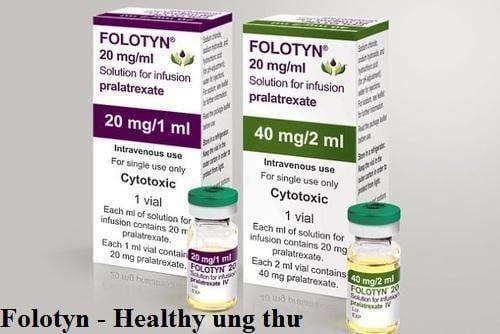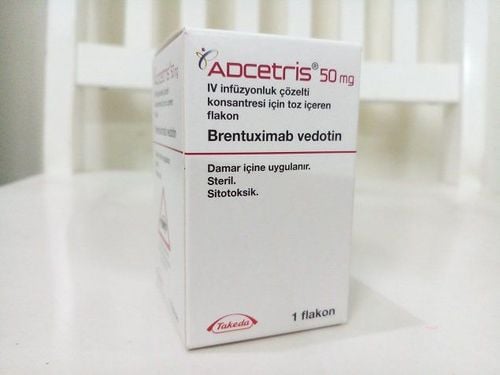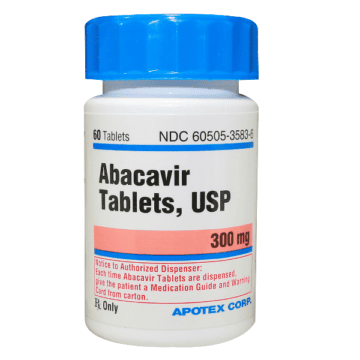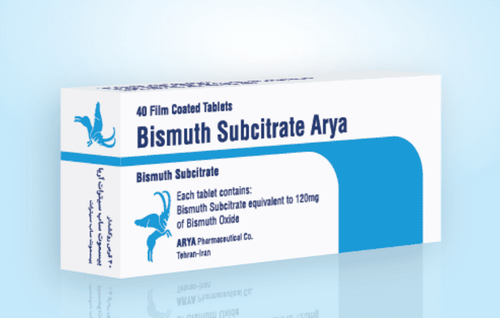This is an automatically translated article.
Posted by Master, Doctor Mai Vien Phuong - Gastrointestinal Endoscopy - Department of Medical Examination & Internal Medicine - Vinmec Central Park International General Hospital.MALT lymphoma is a form of lymphoma that involves lymphatic tissue that is associated with the mucosa. Accordingly, gastric MALT tumors are known to respond to local infection by H. pylori, which is present in more than 90% of these lymphomas. To colonize the stomach, H. pylori must pass through the acidic environment of the stomach and into the gastric mucosa.
1. What is ocular MALT lymphoma?
MALT lymphoma is a form of mucosal-associated lymphoid tissue (MALT) lymphoma that has features that distinguish it from all other forms of primary extranodal lymphoma. Ocular adnexal lymphoma is mainly found in older adults with a slight predominance in women. It occurs in the orbit, conjunctiva, and lacrimal glands, in descending order of frequency. From a histological point of view, this condition is characterized by a large prevalence of borderline B-cell histological types and varying degrees of infiltration of reactive T cells.
2. Clinical manifestations
The clinical manifestations depend on the identification of the damaged structures. For example, 25% of MALT lymphomas involve the conjunctiva. Intraorbital masses are present in 75% of cases, while bilateral association occurs in 10%–15% of cases. Intraorbital lymphoma is variously associated with ocular protrusions, palpable masses or nodules, eyelid protrusion, diplopia, protrusion, and impaired ocular motility.
Its clinical presentation usually consists of a single, slow-growing, painless mass that displaces normal structures. However, its presentation can also be acute, with inflammatory-like signs and symptoms. Infiltration into the eye is exceptional.

3. Pathogenicity of H.pylori
Gastric MALT tumors are known to acquire in response to local infection by Hp, present in more than 90% of these lymphomas. To reside in the stomach, Hp must pass through the acidic environment of the stomach and then to the gastric mucosa. The hydrolysis of urea with the generation of ammonia may allow the existence of this acid-sensitive organism in the gastric mucosa. Furthermore, the ammonia produced by urea hydrolysis can also produce severe cytotoxic effects in the gastric epithelium. Due to its helical shape and numerous polar flagella, which are used for peristalsis, Hp adhere through the mucous layer and to the gastric epithelium, where they adhere to its cells using an adhesive. Of those infected, about 10% develop peptic ulcer disease; 1% to 3% develop gastric adenocarcinoma and <0.1% develop MALT lymphoma.
4. Mechanism of gastric MALT tumor formation
Contact between Hp and gastric epithelium induces an immune and inflammatory response. This activates the transcription factor NF-kB, induces proinflammatory chemokines, and acquires neutrophils, monocytes, macrophages, and dendritic cells. Furthermore, this response regulates processes involved in B-cell development, growth, and survival by producing cytokines and growth factors, and may also be responsible for activating cell death sequence.
Then, an adaptive immune response to Hp infection emerges from macrophages and dendritic cells located in the lining of the gastric mucosa. Neutrophils, monocytes, and macrophages can phagocytocyte Hp, but they appear to be able to achieve this without intracellular destruction, as Hp can persist in monocytes for up to 48 years. hour. The immune response does not eliminate Hp leading to chronic inflammation of the gastric mucosa. Sequential progression from chronic inflammation to mucosal atrophy, metaplasia, dysplasia leads to carcinogenesis. In a small number of individuals, chronic inflammation from persistent Helicobacter pylori infection may give rise to lymphoid tissue in the gastric mucosa, eventually progressing to MALT-type low-grade gastric B-cell lymphoma. Immunity to Hp and gastric immune-mediated injury are T-cell dependent. The prolonged interaction between bacteria and host immune mechanisms makes Hp an infectious agent. plausible to trigger autoimmunity through molecular mimicry.
The tumor cells of low-grade gastric MALT lymphoma (MALtoma) are B cells that remain responsive to differentiation signals, such as cytokines produced by antigen-stimulated T cells and depends on the stimulation of Hp-specific T cells for growth. The activity of these specific T cells, is defective in both perforin and Fas ligand-mediated cytotoxicity. Thus promoting both B-cell overgrowth and complete proliferation of B-cells.
In gastric mucosal cells, there are elevated levels of cytokines, including proliferative ligands ( APRIL), belongs to the tumor necrosis factor family. APRIL is produced by macrophages present in gastric MALT infiltrate, is close to neoplastic cells, and can also induce B-cell transformation and their progression to B-cell lymphoma large and widespread. APRIL produced by macrophages can be enhanced and maintained by activated T lymphocytes.
Survival and transformation of B cells in malignant lymphoma require additional signals. They come from T cells or directly from self-antigenous stimulation of lymphoma cells. Thus, one or more neoplastic clones, derived from gastric MALtomas, may express molecules that strongly stimulate B-cell activation and proliferation, localizing and displacing primary follicles. . Ultimately destroys gastric glands to form lymphoid epithelial lesions and ultimately precipitates the onset of low-grade gastric MALT lymphoma. Although, MALT lymphoma is usually slow growing and has a low propensity to spread, a small percentage of cases undergo high grade transformations.
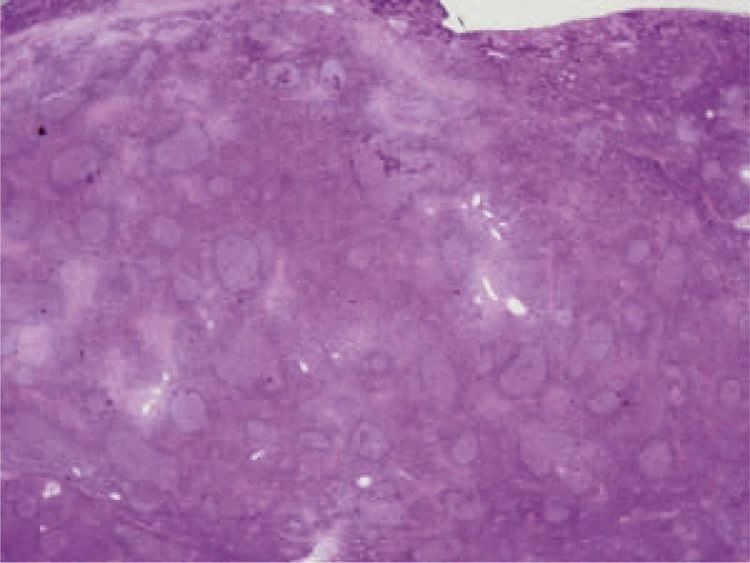
B-cell marginal lymphoma of mucosa-associated lymphoid tissue (MALT lymphoma): lymphoma cells infiltrate around reactive B-cell follicles, outside the preserved capsule envelope, in a border distribution. Borderline B cells are characterized by small and medium size. Most patients have stage I or II disease. MALT lymphoma and its natural course are solitary and slow to spread; The recurrence may involve other sites.
5. Mechanism of ocular adnexal MALT tumor formation
Multiple MALT lymphomas at ocular adnexal sites are associated with infectious etiology, supporting an antigen-driven lymphoma origin model. According to this model, infection first induces chronic antigenic stimulation of B cells and antibody production. The proliferation of B-cell lines becomes antigen-independent and with uncontrolled proliferation, malignant transformations can occur. However, not all people who are infected with the Hp virus also get MALT lymphoma. This indicates that the role of genetic factors is important, as gastric MALT lymphoma presents with a wide range of recurrent genomic lesions, including chromosomal translocations and disproportionate aberrations. . The accumulation of genetic abnormalities is associated with loss of dependence from antigenic stimuli (with subsequent antibiotic resistance) and possible histological changes. Furthermore, 10%-20% of patients do not respond to Hp eradication treatments. This group often has chromosomal translocations, which suggests that there is another genetic mechanism of MALT lymphoma that is still unknown.
A higher incidence of MALT lymphoma has been reported in patients with chronic Helicobacter pylori infection, as well as in those with Sjögren's syndrome. Similarly, patients with Sjögren's syndrome have a much higher incidence of developing lymphoma, most of which are of the MALT type. Further studies are needed before Hp can be considered as a significant contributor to the etiology of conjunctival MALT lymphoma.
Please dial HOTLINE for more information or register for an appointment HERE. Download MyVinmec app to make appointments faster and to manage your bookings easily.
References
Sergio Claudio Saccà, MD, Aldo Vagge, Helicobacter pylori Infection and Eye Diseases: A Systematic Review. Medicine (Baltimore). 2014 Dec; 93(28): e216.






